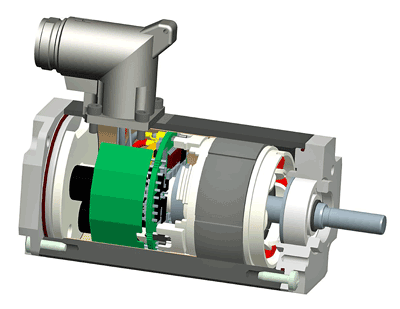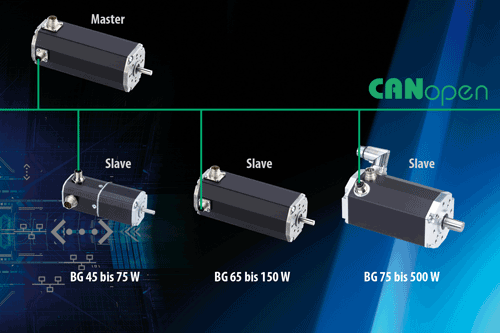The third wave of distributed motion aids reliability, MTBF
BY JOHN MOREHEAD, Vice President, Business Development
Dunkermotoren USA
www.dunkermotor.com
Just as fractional horsepower gearmotors freed factories in the 1920s from their cumbersome, inefficient, and unreliable overhead “networks” of shafts and pulleys connected by leather belts, today’s brushless servo motors with integral intelligent control allow machine builders to shorten product development time, reduce wiring complexity and installation costs, and increase machine efficiency and reliability. Integrated motor/controls allow design engineers more time to focus on the control architecture more specific to the machine’s problem at hand.
Distributed motion history
Aside from water-wheel-powered saw and grist mills of the 18th century, the first wave of modern distributed motion followed the industrial revolution in the late 19th century when factories began using one or more of the early large, floor-mounted electric motors to drive a complex system of ceiling-mounted lineshafts, bearing supports, spindles and pulleys that distributed motion to where the work was being done.
A second wave came in the 1920s, with the advent of small fractional horsepower gearmotors which could be matched to the individual application requirements of diverse pieces of machinery and were compact enough to mount directly on the machinery. This brought about significant productivity and reliability gains by eliminating the typical problem of the whole plant being down when a prime mover failed or required maintenance.
In the late 20th century, innovators in the motors and motion control industries recognized that advances in electronic components were a big help in developing brushless dc motor applications by integrating the formerly discrete motor and control together into a compact, single component only slightly larger than the motor itself. The challenge then was to design controls compact enough to fit the motor’s form factor and perform reliably over a realistic lifetime when attached to a source of inherent heat generation.
From the mid-1990s onward, a variety of brushless motors with integrated controls were introduced with capabilities ranging from simple speed to full-on intelligent servo motor control. The systems incorporated the motor, power electronics, controller, software, feedback, I/O and communications in a single mechatronic component. This third wave of distributed motion moves away from large, expensive centralized controls, enclosures, and unnecessary wiring and incorporates the motion controls directly into the individual axes of motion.
Types of integral control brushless motors
Brushless motors with some form of controls built-in offer a wide variety of capabilities.

• Integrated commutation electronics: Perhaps the simplest embodiment and in some applications an easy, long-life, maintenance-free drop-in replacement for brushed dc motors. Many of these two-wire motors are for single-direction applications, as in pumps, and offer not only simple speed control by varying the dc voltage, but in most cases the life of the motor is increased by a factor of five or more. Variations have the ability to reverse direction and stop and hold via more I/O.
• Integrated 4-quadrant digital speed control: These motors can be commanded through digital inputs to run in either direction, stop and hold with torque, or coast to a stop. Other inputs can switch between preset speeds or allow for variable analog speed reference. Accel/decal ramps can be programmed and digital outputs give hall-effect pulses, direction of rotation, and ready/error state information back to a programmable logic controller.
• Integrated positioning control: These motors can close a position loop. Initially, the selection of the mode of operation (analog or digital torque or speed control and relative, absolute and/or modulo position control) is set up via a GUI and the parameters are downloaded to the motor. Once set-up, it runs as a stand-alone, programmed servo which interfaces to the rest of the machine via digital and analog I/O.
• Integrated master electronics: These motors have the ability to be a master in a network of several other motors. Like the integrated positioning control motor, it requires no higher level controller, but it is not limited to standard operating modules and is freely programmable to the application needs and can close current, velocity, and position loops or control slave node motors.
• Integrated CANopen electronics: Integrating CANopen electronics follows the trend in machine design to use distributed control of not only I/O devices, but motors as well and functions as a single node on a CAN of up to 126 motors. The ability to access each motor through the CAN network may eliminate the need for separate I/O modules and/or PLC altogether.
• Integrated Profibus electronics: Integrating these electronics is similar to the CANopen version noted above but functions as a slave on a Profibus DP network.
• Integrated EtherCAT electronics: These are designed to be a slave on an EtherCAT network and CANopen over Ethernet (CoE) is supported.
Benefits of integrated control
There are many benefits of integrated control brushless motors, and the one that gets the most attention is reduced cost. When specifying brushless motors in the past, it was not unusual that the requisite standalone electronics to provide the commutation and simple speed-control capabilities cost more than half as much as the motor itself, not to mention the wire or cabling and connectors needed to mate the two components. The integrated control approach is much more economical.

Other economies come in to significantly reduce installation and start-up time, as this type of motor approaches plug-and-play. Brushless dc motors are typically higher in efficiency than the motors they replace and can significantly reduce energy costs. Many of today’s integral control motors are also available with high environmental protection ratings like IP65 and as a single, integrated unit offer rugged high reliability. The integrated control solution saves space and greatly simplifies the machine’s overall layout, wiring, and parts count. Integral controls also reduce EMI.
When networked, integral control motors can reduce bus load and, with integral encoders, are easy to connect. Some versions also provide important emergency capabilities, such as returning to a safe position when there is a network failure.
From a reliability standpoint, some integrated controls yield an MTTF of 650,000 hours and, as noted, brushless motors typically offer five times the life of brushed motors. Should there be a problem, the time required to diagnose and replace a single component is significantly reduced. And, the inevitable “finger pointing” by discrete component suppliers is eliminated. A big benefit for machine builders adopting these motors is the continued advancements in the field of silicon and software that contribute to the advancement of these solutions not only from a performance and reliability standpoint, but in terms of value.
One example of an integral control brushless motor would be the BG45x15PB from Dunkermotor; a compact 12 to 24-V, 47-W BLDC motor that is 45 mm (or 1.77 in.) square. It has a Profibus interface, integral encoder, and four-quadrant positioning motion control. This highly reliable unit can perform complex motion profiles and dynamic positioning. The standard unit has a list price of $774 and is available with optional planetary or right-angle gearing and a power-off brake. Dunkermotor produces integral control brushless motors in a range of different sizes with up to 550-W poweroutput. ■
Advertisement
Learn more about Dunkermotoren USA





